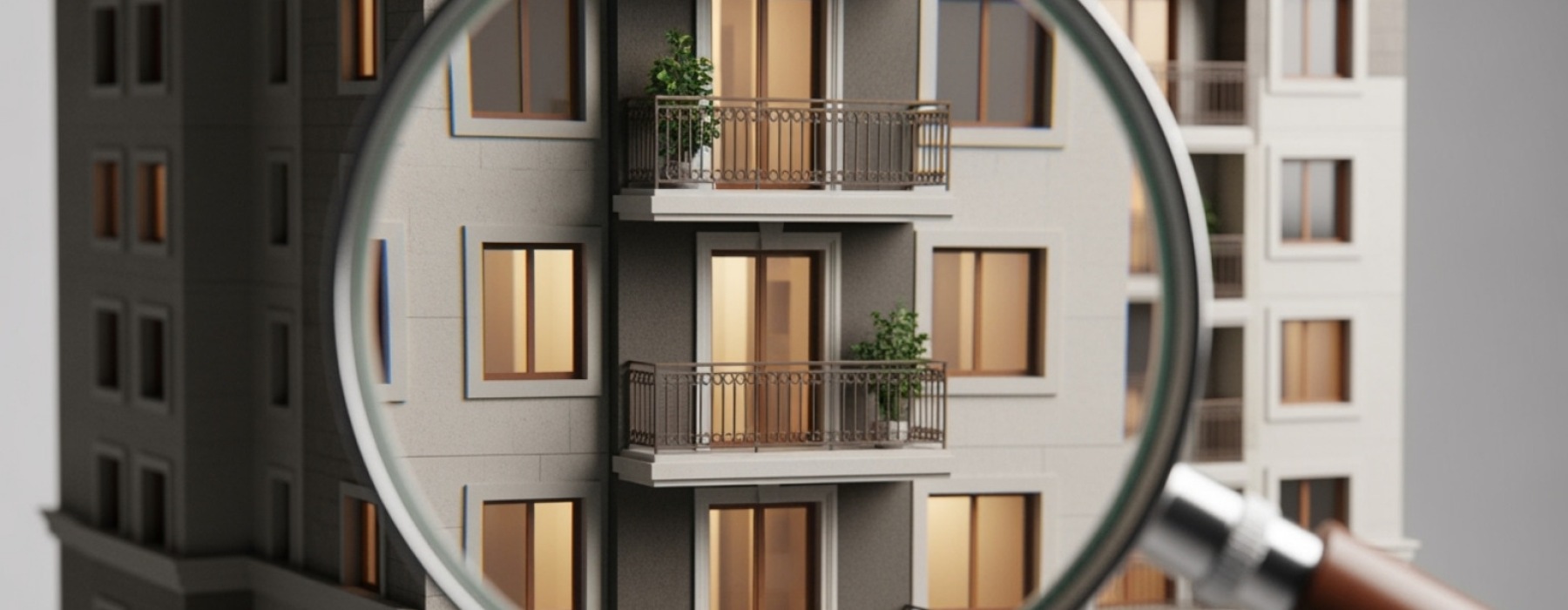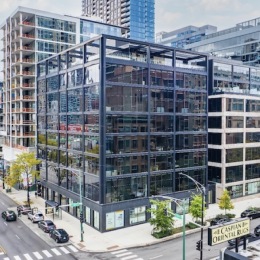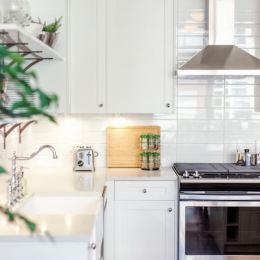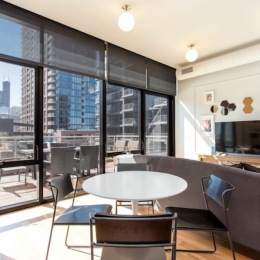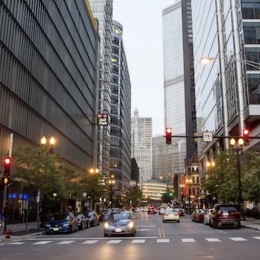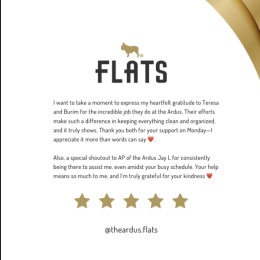Your Chicago Apartment Search Guide
Apartment complexes in Chicago IL offer something for every lifestyle, from sleek high-rise towers with panoramic lake views to converted warehouse lofts with exposed brick charm. With over 23,000 rental units across the city, Chicago's diverse neighborhoods each bring their own personality to urban living.
Top Chicago apartment complex neighborhoods include:
- River North - Converted warehouses, art galleries, vibrant nightlife
- West Loop - Culinary hotspot with modern loft living
- Lincoln Park - Lakefront access with tree-lined streets
- South Loop - Cultural attractions and historic architecture
- Lakeview - Beach proximity with neighborhood charm
Chicago's rental market spans everything from 61% high-rise buildings averaging 19 stories to intimate courtyard communities with vintage details. Whether you're drawn to floor-to-ceiling windows overlooking the Chicago River or prefer a quiet tree-lined block near Lincoln Park Zoo, the city's apartment complexes cater to professionals, students, and families alike.
The variety is striking. Studio apartments represent 22% of units, while 1-bedroom layouts make up 51% of available rentals. About 41% of buildings were constructed since 2000, meaning you'll find both modern amenities like rooftop pools and smart home technology alongside classic features like hardwood floors and ornamental lobbies.
Most complexes now offer the amenities that matter most to urban dwellers: fitness centers, coworking spaces, rooftop decks, and pet-friendly policies. Many also include practical perks like bike storage, package lockers, and EV charging stations.
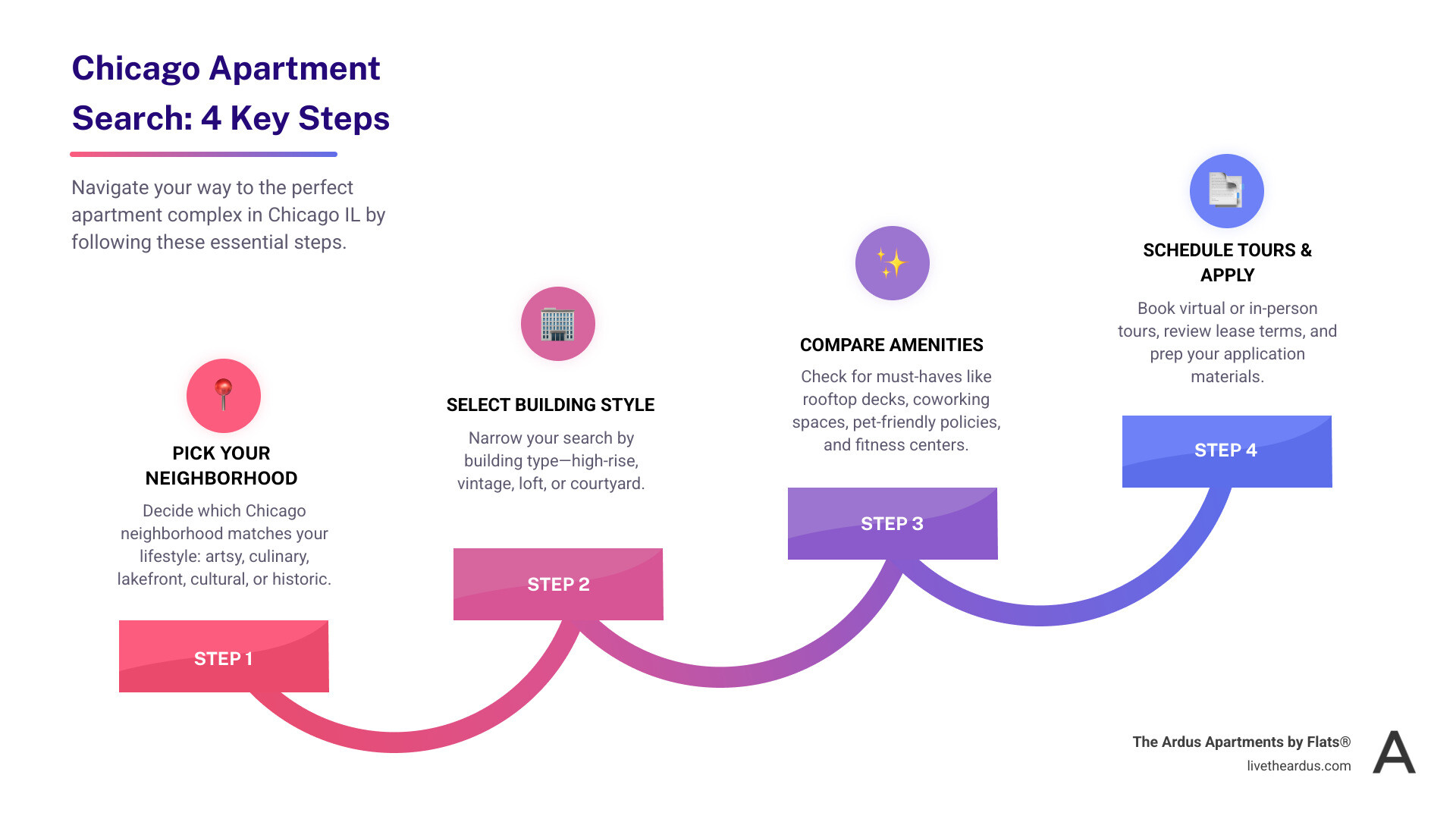
Chicago Neighborhoods & Their Signature Vibes
Chicago's neighborhoods each offer distinct living experiences, from the busy energy of downtown districts to the tree-lined tranquility of lakefront communities. Understanding these neighborhood personalities helps you find apartment complexes in Chicago IL that match your lifestyle preferences.
The city's excellent public transportation system, anchored by the CTA 'L' lines, connects these diverse areas seamlessly. Most neighborhoods feature high walkability scores, with River North and the Loop earning Walk Scores of 86 or higher. This connectivity means you can live in a quieter residential area while maintaining easy access to downtown employment centers and entertainment districts.
River North apartment complexes in Chicago IL: Artsy Warehouse Chic
River North stands out as Chicago's premier destination for converted warehouse living. This neighborhood perfectly balances historic industrial architecture with contemporary urban amenities. The area's signature red-brick buildings and timber-beam construction create distinctive loft-style apartments that you won't find in traditional high-rise developments.
The neighborhood pulses with creative energy, thanks to its concentration of art galleries, design studios, and innovative restaurants. Many apartment complexes in Chicago IL located here feature ground-floor retail spaces, creating vibrant mixed-use communities where residents can grab morning coffee downstairs or browse local boutiques after work.
Modern Living Chicago showcases how these converted spaces blend historical character with modern convenience. Exposed brick walls, soaring ceilings, and oversized windows create dramatic living spaces that feel both industrial and refined.
River North's nightlife scene adds another layer of appeal. The neighborhood's proximity to downtown means you're walking distance from premier dining, entertainment venues, and cultural attractions. Yet the residential streets maintain a more intimate feel than the busy Loop district.
West Loop: Culinary Hotspot Meets Loft Living
The West Loop has transformed from an industrial district into Chicago's most dynamic culinary destination. Fulton Market, the neighborhood's heart, hosts an impressive concentration of James Beard Award-winning restaurants alongside trendy cafes and craft breweries.
This neighborhood exemplifies successful adaptive reuse, with former meatpacking facilities and warehouses now housing luxury apartment complexes. These conversions often feature dramatic ceiling heights, polished concrete floors, and floor-to-ceiling windows that flood spaces with natural light.
The West Loop's dog parks and green spaces provide welcome respite from urban density. Mary Bartelme Park, with its distinctive curved bridges and modern playground, serves as a neighborhood gathering spot. Many apartment complexes here incorporate pet-friendly amenities, recognizing that the area attracts young professionals who consider their pets family members.
Lakefront apartment complexes in Chicago IL: Lincoln Park & Lakeview
Lincoln Park and Lakeview offer the rare combination of urban convenience and natural beauty. These neighborhoods provide direct access to Lake Michigan's shoreline, with miles of bike paths, beaches, and parkland literally at your doorstep.
Lincoln Park's tree-lined streets create a more residential feel while maintaining excellent connectivity to downtown. The neighborhood's mix of vintage courtyard buildings and modern high-rises means you can choose between classic Chicago architecture and contemporary amenities.
Lakeview extends this lakefront lifestyle northward, offering slightly more space and a neighborhood feel. The area's proximity to Wrigleyville adds sports excitement, while the lakefront trail system provides year-round recreation opportunities.
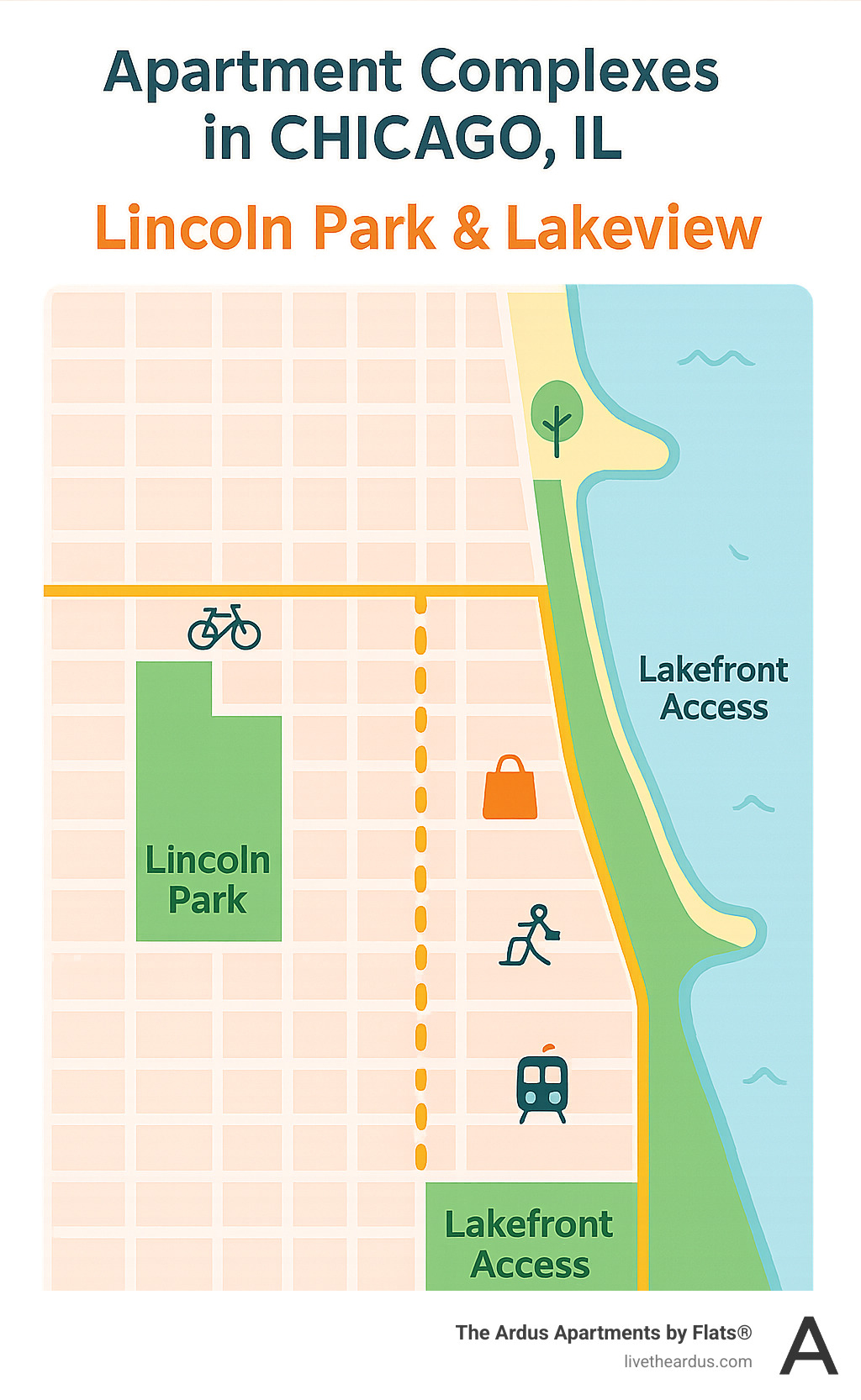
Both neighborhoods feature excellent public transportation access, with multiple 'L' lines providing quick downtown connections. The Red and Brown lines make commuting straightforward, while the lakefront location offers unique recreational opportunities that most urban areas can't match.
South Loop & Hyde Park: Culture and Campus Energy
The South Loop combines cultural attractions with modern living spaces. This neighborhood puts you within walking distance of world-class museums, Soldier Field, and Grant Park's expansive green spaces. The area's high-rise apartment complexes often feature dramatic city and lake views, taking advantage of the neighborhood's proximity to the lakefront.
Hyde Park brings a different energy, anchored by the University of Chicago's campus. This neighborhood attracts graduate students, faculty, and young professionals who appreciate its intellectual atmosphere and historic architecture. The area's tree-lined streets and stately buildings create a more contemplative environment while maintaining urban conveniences.
Both neighborhoods offer excellent museum access, from the Field Museum and Shedd Aquarium in the South Loop to the Museum of Science and Industry in Hyde Park. This cultural richness attracts residents who value educational and artistic opportunities alongside modern apartment living.
Must-Have Amenities Chicago Renters Demand
Modern apartment complexes in Chicago IL compete on amenities that support urban lifestyles. Today's renters expect more than just four walls and a roof – they want spaces that improve their daily routines and support their personal and professional goals.
The most sought-after amenities reflect how urban living has evolved. Fitness centers are now standard, but they're joined by coworking lounges that support remote work, rooftop decks that provide outdoor space in dense urban environments, and smart home technology that streamlines daily tasks.
Package lockers have become essential as online shopping continues growing. These secure delivery systems solve the challenge of receiving packages when you're at work, providing 24/7 access to deliveries in a secure environment.
Wellness & Work From Home Perks
The shift toward remote and hybrid work has transformed apartment amenity expectations. Coworking spaces within apartment complexes provide professional environments when your apartment feels too casual or cramped. These spaces typically feature high-speed Wi-Fi, printing capabilities, and quiet zones for video calls.
Yoga studios and meditation rooms address the wellness side of modern living. These dedicated spaces allow residents to maintain fitness routines without expensive gym memberships or crowded public facilities. Many complexes also include outdoor yoga decks or rooftop meditation areas that take advantage of Chicago's skyline views.
High-speed internet has moved from luxury to necessity. Most modern complexes now offer gigabit internet as a standard amenity, recognizing that reliable connectivity supports both work-from-home arrangements and entertainment streaming.
Pet-Friendly Policies (Two-Pet Limit)
Chicago's apartment complexes have acceptd pet-friendly policies, with most allowing up to two pets per unit. This reflects the reality that many urban dwellers consider their pets essential family members rather than optional companions.
Pet Friendly Apartments River North demonstrates how complexes can integrate pet amenities seamlessly into their communities. Bark parks provide off-leash exercise areas, while pet wash stations offer convenient grooming facilities.
Modern pet policies typically include breed guidelines rather than blanket restrictions, focusing on individual pet behavior rather than breed stereotypes. Many complexes also provide pet-sitting services or partnerships with local pet care providers, recognizing that urban pet ownership requires additional support systems.
Social & Leisure Spaces
Community spaces have evolved beyond basic clubrooms to include sophisticated entertaining areas. Outdoor grills and fire pits create gathering spots for residents to connect with neighbors. Community kitchens with professional-grade appliances support larger gatherings and cooking enthusiasts.
Game rooms now feature both classic options like pool tables and modern entertainment like gaming consoles and large-screen TVs for sports viewing. These spaces recognize that apartment living doesn't mean sacrificing social opportunities.
Pool decks and rooftop lounges take advantage of Chicago's summer weather, providing resort-style amenities in urban settings. These spaces often include cabanas, outdoor bars, and dramatic city views that make staying home feel like a vacation.
Connected Living
Modern apartment complexes integrate seamlessly with urban transportation networks. Bike storage facilities protect expensive bicycles while encouraging eco-friendly commuting. Many complexes now include bike repair stations and partnerships with bike-sharing programs.
EV charging stations address the growing number of electric vehicle owners, providing convenient charging without the need for street-side hunting. These amenities position complexes for future transportation trends while serving current residents' needs.
App-based access systems eliminate the need for physical keys while providing improved security. These systems allow residents to grant temporary access to guests, receive delivery notifications, and control apartment features remotely.
Scientific research on walkability and health demonstrates how urban design affects resident wellbeing. The most successful apartment complexes integrate with their neighborhoods' walkability features, providing easy access to public transit, grocery stores, and recreational facilities.
Types of Apartment Complexes in Chicago IL
Chicago's diverse architectural landscape offers distinct apartment complex styles, each with unique advantages and characteristics. Understanding these different building types helps you identify which style best matches your lifestyle preferences and space needs.
The city's rental market includes everything from soaring glass towers to intimate courtyard buildings, with 67% of apartments located in smaller complexes with fewer than 50 units and 26% in large buildings of 50 or more units. This variety means you can choose between the amenities and services of large-scale developments or the intimate community feel of smaller buildings.
High-Rise Icons on the River
Chicago's high-rise apartment complexes define the city's skyline and offer unparalleled urban living experiences. These towers, often 30 stories or higher, provide panoramic views of Lake Michigan, the Chicago River, and the city's architectural landmarks.
High-rise living comes with premium amenities that smaller buildings can't offer. Concierge services handle everything from package delivery to restaurant reservations. Sky terraces and rooftop pools create outdoor spaces that take advantage of liftd positions, offering dramatic sunset views and entertainment areas high above street level.
The elevator systems in these buildings are designed for efficiency, with multiple high-speed elevators and advanced traffic management systems. Many high-rises also include retail spaces on ground floors, creating convenient access to services like dry cleaning, banking, and dining.
Security in high-rise buildings typically includes 24/7 front desk staffing, controlled access systems, and surveillance monitoring. These features provide peace of mind for residents who travel frequently or work irregular hours.
Vintage & Courtyard Classics
Chicago's vintage apartment buildings showcase the city's architectural heritage while providing unique living experiences. These buildings, many dating from the early 1900s, feature terra-cotta facades, ornamental lobbies, and craftsmanship details that modern construction rarely matches.
Courtyard buildings create intimate communities around central green spaces. These designs provide natural light and ventilation while fostering neighbor connections. Many feature original hardwood floors, high ceilings, and built-in storage solutions that demonstrate thoughtful period design.
Tree-lined streets in neighborhoods like Lincoln Park and Lakeview improve the vintage building experience. These locations offer walkability to local shops and restaurants while maintaining residential character that high-density areas sometimes lack.
Vintage buildings often require more maintenance than newer construction, but they offer character and space proportions that appeal to residents who value architectural history. Many have been carefully updated to include modern amenities while preserving their historic charm.
Adaptive Reuse Warehouses
Chicago's industrial heritage creates unique opportunities for warehouse conversions that blend historical character with contemporary living. These adaptive reuse projects transform former manufacturing and storage facilities into distinctive apartment complexes.
Exposed brick walls, timber beam construction, and soaring ceilings create dramatic living spaces that feel both industrial and refined. Large windows, originally designed for industrial lighting, flood these spaces with natural light while providing interesting urban views.
River North Studio Apartments exemplifies how warehouse conversions can create efficient yet spacious living environments. The open floor plans and high ceilings make even smaller units feel expansive and flexible.
Sustainability often drives these conversion projects, as repurposing existing structures reduces environmental impact compared to new construction. Many incorporate green building features like energy-efficient systems and sustainable materials while preserving the building's industrial character.
Navigating Apartment Complexes in Chicago IL: Search, Tours & Leasing
Finding the right apartment complex requires strategic planning and efficient use of available resources. Chicago's rental market moves quickly, with desirable units often receiving multiple applications within days of listing. Understanding the search and leasing process helps you move confidently from initial research to signed lease.
Online platforms have revolutionized apartment hunting, but they're most effective when combined with local knowledge and professional guidance. Virtual tours and detailed photos provide initial screening capabilities, while in-person visits reveal details that photos can't capture.
Building Your Shortlist
Effective apartment searching starts with clear priorities and realistic expectations. Filter tools on rental websites allow you to narrow options by location, unit size, and specific amenities. However, the most successful searches balance must-have features with flexibility on less critical details.
Saved searches and email alerts help you respond quickly to new listings. In Chicago's competitive market, the best units often receive applications within hours of posting. Setting up multiple saved searches with slightly different criteria ensures you don't miss opportunities.
Chicago River North Apartment options demonstrate how location preferences can guide your search strategy. River North's central location and transportation access make it attractive to professionals, but this popularity means higher demand and faster turnover.
Consider creating a spreadsheet to track properties you're considering, including key details like lease terms, included utilities, and pet policies. This organization helps you compare options objectively when you're ready to make decisions.
Touring Like a Pro
Virtual tours have become sophisticated tools that provide detailed property previews from anywhere. 3D tours allow you to explore layouts and get a feel for space proportions before scheduling in-person visits. However, virtual tours can't reveal noise levels, natural light quality, or neighborhood character.
Self-guided tour options provide flexibility for busy schedules while allowing you to explore at your own pace. Many complexes now offer app-based access for self-guided tours, though having a leasing professional available for questions remains valuable.
Prepare specific questions for leasing teams about policies and procedures that matter to your situation. Ask about guest policies, package handling, maintenance response times, and any upcoming building improvements or construction that might affect your living experience.
Bring proper identification and basic financial documentation to tours, as competitive markets sometimes require immediate application submission. Having these materials ready demonstrates serious intent and allows you to act quickly on units you love.
Lease Signing & Move-In
The lease signing process involves more than just signatures – it's your opportunity to understand all terms and conditions that will govern your tenancy. Review lease documents carefully, paying attention to policies regarding lease renewal, subletting, and early termination.
Application fees and security deposits vary significantly between properties. Some complexes offer alternatives to traditional security deposits, such as monthly insurance premiums or guarantor programs. Understanding these options helps you choose arrangements that work best for your financial situation.
Renter's insurance is typically required and provides valuable protection for your personal belongings. Many complexes can recommend insurance providers or offer group policies that simplify the process while potentially reducing costs.

Utility setup should begin before your move-in date to ensure services are active when you arrive. Most complexes provide guidance on local utility providers and may include some utilities in rent. Understanding what's included helps you budget accurately for monthly expenses.
Commute & Mobility Considerations
Chicago's public transportation system significantly impacts apartment complex desirability. The CTA 'L' lines provide efficient connections throughout the city, while Metra trains serve suburban areas. Proximity to transit stations often correlates with higher demand and faster leasing cycles.
Divvy bike-share stations expand mobility options, especially for short trips and recreational activities. Many apartment complexes now include bike storage and maintenance facilities, recognizing that cycling is both transportation and recreation for urban residents.
Protected bike lanes have expanded throughout Chicago, making cycling safer and more practical for daily commuting. When evaluating apartment locations, consider both current bike infrastructure and planned improvements that might improve future connectivity.
Ride-share pickup and drop-off areas matter for residents who rely on these services. Some apartment complexes designate specific areas for ride-share vehicles, reducing wait times and improving convenience for residents and drivers.
More info about amenities can help you understand how different features support various transportation and lifestyle choices.
Frequently Asked Questions About Apartment Complexes in Chicago IL
What building styles dominate Chicago's rental market?
High-rise buildings represent the majority of Chicago's rental market, with 61% of rental communities being high-rise buildings averaging 19 stories. However, the city maintains significant diversity in building types, from vintage courtyard buildings to modern mid-rise developments.
The mix includes both new construction and adaptive reuse projects. 41% of Chicago's apartment buildings have been built since 2000, representing newer options with contemporary amenities, while older buildings offer character features like hardwood floors, high ceilings, and architectural details that modern construction rarely matches.
How pet-friendly are most apartment complexes?
Most apartment complexes in Chicago IL welcome pets, typically allowing up to two pets per unit. Common pet amenities include bark parks, pet wash stations, and designated pet relief areas. Many complexes focus on individual pet behavior rather than breed restrictions, though some guidelines may apply.
Pet policies usually include monthly pet fees and may require additional deposits. Some complexes offer pet-sitting services or partnerships with local pet care providers, recognizing that urban pet ownership requires additional support systems.
What should I prepare before scheduling tours?
Bring photo identification and basic financial documentation, including recent pay stubs or employment verification. Having these materials ready demonstrates serious intent and allows you to submit applications immediately for units you want.
Prepare a list of specific questions about policies that matter to your situation, such as guest policies, package handling, maintenance response times, and any upcoming building improvements. Consider your preferred move-in date and lease term length, as flexibility on timing can sometimes provide more options.
Conclusion
Chicago's apartment complex landscape offers remarkable diversity, from soaring high-rise towers with panoramic lake views to intimate courtyard buildings with vintage charm. Whether you're drawn to the converted warehouse aesthetic of River North, the culinary energy of the West Loop, or the lakefront tranquility of Lincoln Park, the city's neighborhoods each provide distinct living experiences.
The key to finding your perfect Chicago apartment lies in understanding your priorities and exploring different building types and neighborhoods. High-rise living offers premium amenities and dramatic views, while vintage buildings provide character and architectural details that modern construction rarely matches. Adaptive reuse warehouses create unique spaces that blend industrial history with contemporary comfort.
Modern amenities have evolved to support urban lifestyles, with fitness centers, coworking spaces, and rooftop decks becoming standard features. Pet-friendly policies, smart home technology, and sustainable building practices reflect how apartment complexes in Chicago IL continue adapting to resident needs and preferences.
The Ardus Apartments by Flats® exemplifies this evolution, changing a former River North warehouse into stylish living spaces that honor the building's industrial heritage while providing contemporary amenities like rooftop lounges and on-site coffee shops. This approach to adaptive reuse demonstrates how Chicago's apartment complexes successfully blend historical character with modern convenience.
New River North Apartments continue this tradition of innovation, offering residents the best of both worlds – the energy and convenience of urban living with the character and community that make Chicago neighborhoods special.
Your next Chicago apartment awaits in a city that celebrates both its architectural heritage and its innovative future. Whether you choose a high-rise with concierge services or a converted warehouse with exposed brick walls, you'll find that Chicago's apartment complexes offer more than just places to live – they provide gateways to one of America's most dynamic urban experiences.
